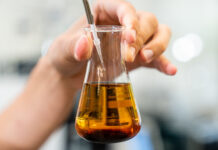 Enzymes have become an important area of biotechnology; the industrial use of enzymes has expanded rapidly into a variety of application fields. The reasons of this success can be explained with their effectiveness, accuracy, use-friendliness, and, last but not the least, the possibility of replacing additives, since existing legislation considers them as technological processing aids
Enzymes have become an important area of biotechnology; the industrial use of enzymes has expanded rapidly into a variety of application fields. The reasons of this success can be explained with their effectiveness, accuracy, use-friendliness, and, last but not the least, the possibility of replacing additives, since existing legislation considers them as technological processing aids
Biotechnologies are considered the driving industrial area of the next decades, as well as the most promising and with the highest development rate. Substantial public and private investments in biotechnological research and development have been made. Measured by absolute value, expense trends in Europe have grown approximately 20 times since 1980. Within this area, enzymes play a very important role: Over the last thirty years, the use of industrial enzyme preparations has expanded quickly into a variety of application fi elds. There are still enormous opportunities for the development of these high-performance biotechnological aids. The reasons of this success can be explained with their effectiveness, accuracy, use-friendliness, and, last but not the least, the possibility of replacing additives, as the existing legislation considers them as technological processing aids. Being highly selective in their action, enzymes contribute to improve product quality and reduce production costs. In bread production, for instance, alpha amylase used as an ingredient offers several benefits such as improved softness, longer shelf-life, and even reduced baking time, as in the case of pre-baked bread. In the U.S., food industry represents 65% of the market of non-pharmaceutical enzymes. Enzymes are generally derived from animal or vegetable tissues, as well as other preparations obtained by a microbial fermentation process. According to EC Regulation no.1332/2008 of 16 December 2008 “food enzyme means a product obtained from plants, animals, or micro-organisms or products thereof, including a product obtained by a fermentation process using micro-organisms; containing one or more enzymes capable of catalyzing a specific biochemical reaction; and added to food for a technological purpose at any stage of the manufacturing , processing, preparation, treatment, packaging, transport or storage of foods”. The history of modern enzyme technology really began in 1874, when the Danish chemist Christian Hansen produced the first specimen of rennet by extracting dried calves’ stomach with saline solution. Today’s genetic engineering technologies allow the transfer of genes from the source organisms (micro-organisms, animals, plants) to GRAS (Generally Recognized As Safe) organisms, making them available in far larger quantities. Even protein engineering contributes to the development of this area, by “developing” modified enzymes with improved functional properties. An interesting case concerns lysozyme, a β-glucoseaminidase capable of destroying the cell walls of certain bacteria by means of hydrolysis of cell wall polysaccharides. Discovered accidentally by Fleming in 192, it is now widely used in the food industry. Lysozyme is extracted from egg white, but it occurs naturally also in human tears, saliva, and other body fluids. Its function consists in breaking down polysaccharides present in the cell walls of gramnegative bacteria. This polysaccharide consists of alternate units of NAM and NAG.
It is used in the production of some types of cheese (Grana Padano, Provolone, Montasio and Asiago), in order to prevent the socalled butyric late blowing mainly caused by butyric acid bacteria. Article 5 of the guidelines (Disciplinary) for the production of Grana Padano DOP, allows “the use of lysozyme, except for Trentingrana, up to a maximum of 2.5 g per 100 kg milk”. At the beginning of the ’90, it was used also in winemaking in order to prevent lactic acid bacterial activity and malolactic fermentation during aging, contributing to reduce from 2 to 4 times the amount of SO2 used . The use of lysozyme in winemaking is permitted by the EC Regulation no. 2066/2001 at a maximum concentration of 50g/hl. Another significant example concerns a new generation enzyme, called asparaginase, which prevents the formation of acrylamide during cooking processes – but this topic will be discussed here in more detail later. Enzymes are natural catalysers, which, compared to chemical catalysers, offer following properties:
• Specific action for a certain substrate or type of bond in the substrate, which can be compared to that of a key that only opens the lock it has been designed for;
• Reactions produce only one specific product, whereas reactions involving chemical catalysers may produce undesired collateral reactions;
• The reaction rate is related to substrate concentration, temperature and pH;
• Simple use: No special changes to the equipment or to standard operations are required, but only a few simple expedients.





